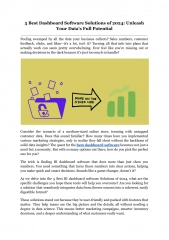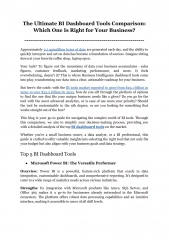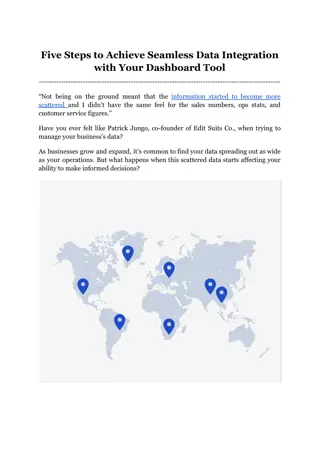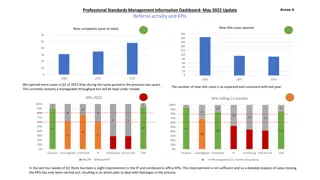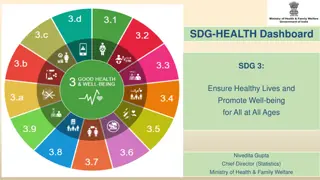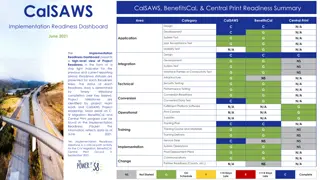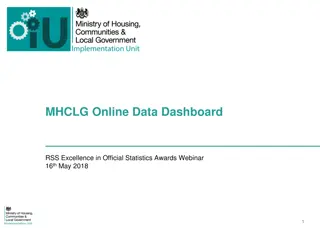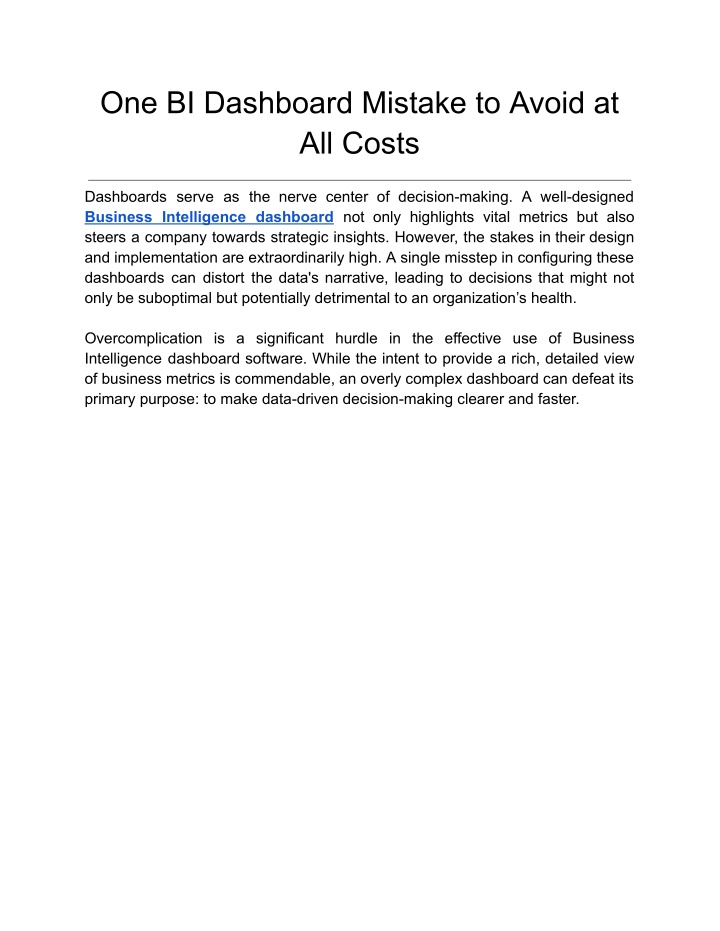
One BI Dashboard Mistake to Avoid at All Costs
Pulling curtains off the major blunder that BI professionals dread, this blog shines a spotlight on the peril of overcomplicated Business Intelligence dashboards. Join us as we dissect the nuances of dashboard design, demonstrating how excessive comp
Download Presentation

Please find below an Image/Link to download the presentation.
The content on the website is provided AS IS for your information and personal use only. It may not be sold, licensed, or shared on other websites without obtaining consent from the author. If you encounter any issues during the download, it is possible that the publisher has removed the file from their server.
You are allowed to download the files provided on this website for personal or commercial use, subject to the condition that they are used lawfully. All files are the property of their respective owners.
The content on the website is provided AS IS for your information and personal use only. It may not be sold, licensed, or shared on other websites without obtaining consent from the author.
E N D
Presentation Transcript
One BI Dashboard Mistake to Avoid at All Costs Dashboards serve as the nerve center of decision-making. A well-designed Business Intelligence dashboard not only highlights vital metrics but also steers a company towards strategic insights. However, the stakes in their design and implementation are extraordinarily high. A single misstep in configuring these dashboards can distort the data's narrative, leading to decisions that might not only be suboptimal but potentially detrimental to an organization s health. Overcomplication is a significant hurdle in the effective use of Business Intelligence dashboard software. While the intent to provide a rich, detailed view of business metrics is commendable, an overly complex dashboard can defeat its primary purpose: to make data-driven decision-making clearer and faster.
Defining Overcomplication At its core, overcomplication occurs when a Business Intelligence dashboard tries to serve too many purposes at once. This is characterized by several common features: Excessive Metrics: Including more metrics than the user can reasonably interpret or act upon. Complex Visuals: Utilizing advanced visualizations that require specific training to understand. Lack of Hierarchy: Failing to differentiate between primary and secondary information, making it hard to quickly identify what's most important.
Common Temptations in BI Dashboard Design and Their Impacts Too Many Widgets Adding multiple widgets to a Business Intelligence dashboard might seem like providing more value, but it can lead to information overload. Each additional widget competes for the user's attention, potentially obscuring crucial data. A leading retail company implemented a dashboard with over 30 widgets on a single screen, intending to provide a comprehensive view. However, the sales team found it overwhelming and time-consuming to locate specific performance metrics, leading to delayed responses to market trends. Excessive Use of Colors While color can effectively differentiate data sets, excessive use can make a Business Intelligence dashboard visually confusing and difficult to interpret. Ideally, colors should be used sparingly to highlight the most important information. Suppose, a financial services firm used a variety of bright colors to represent different data streams within their dashboards. This led to confusion among executives who found it hard to quickly ascertain financial health, resulting in prolonged meetings and indecision. Over-Reliance on Advanced Metrics Advanced metrics are valuable for detailed analysis but placing too many complex calculations on the main dashboard can intimidate or confuse non-technical users. Take, a technology startup that integrated sophisticated predictive analytics into their main operational dashboard. While technically impressive, the inclusion of complex probabilistic models and misinterpretations by team leaders, affecting strategic decisions and operational adjustments. machine learning outcomes led to How to Recognize the Signs of Overcomplication in BI Dashboards
1. Dashboard Loading Time and Responsiveness A clear sign of an overcomplicated Business Intelligence dashboard is poor performance, particularly in terms of loading times and responsiveness. If a dashboard takes excessively long to load or lags frequently, it might be overloaded with complex calculations, high-resolution visuals, or excessive real-time data feeds. Excessive query load times and slow response can often be traced back to non-optimized SQL queries or the pulling of large datasets in real-time. For instance, dashboards that take more than 10 seconds to load can see a user drop-off rate increase by over 50% according to BI usability studies. Implement simplification, and the use of summary tables rather than detailed datasets for real-time analytics. query performance enhancements, such as indexing, query 2. User Interface Complexity An intuitive user interface is key in any business dashboard software. Overcomplication is often evident when users face difficulties navigating through the dashboard, struggle to locate specific metrics, or cannot easily understand the data representations. Complex navigation menus, too many dropdowns, or layered interfaces can indicate that the dashboard is not optimally designed. A cluttered user interface with multiple widgets and controls can lead to cognitive overload. Research indicates that a user interface with more than 7 +/- 2 interactive elements can exceed the typical user s cognitive load, reducing the efficiency of data retrieval and interpretation. Adopt a minimalist design philosophy. Utilize tabs or drill-down functionality to keep the initial view simple, while still allowing users detailed access when needed. Employing dashboard design standards such as Fitts Law can also enhance usability by minimizing physical effort and the cognitive time to locate dashboard elements. 3. Data Interpretation Challenges If users require frequent assistance to understand or interpret the dashboard outputs, this could indicate that the Business Intelligence dashboard software
is too complex. Overuse of advanced statistical metrics, lack of clear labels, or convoluted graph designs are common culprits that hinder straightforward data interpretation. Overuse of complex statistical measures or advanced predictive analytics on a primary dashboard can confuse users who are not data scientists. For example, incorporating Bayesian probability or multivariate regression analyses directly into high-level dashboards might obscure rather than clarify key insights. Ensure that advanced analytics are included in a separate dashboard layer or use tooltips and help text to explain these elements. Offering an 'Analytics Glossary' within the dashboard can aid users in understanding complex metrics. 4. Low User Engagement Regular usage metrics can offer insights into dashboard complexity. A decline in user engagement or selective usage of only certain features may suggest that users feel overwhelmed by some parts of the dashboard. This is particularly
telling if the dashboard features extensive tools or data sets that remain largely untouched. Dashboard adoption rates and engagement metrics can reveal overcomplication. If less than 20% of potential users interact with certain dashboard features regularly, this could indicate that those features are either irrelevant or too complex. Conduct A/B testing to compare different dashboard layouts and functionalities, focusing on those that increase user interaction rates. Use embedded analytics to track which features are used most and least, and refine the dashboard based on this data. 5. Feedback from Users Direct feedback from users is invaluable. Complaints about the dashboard being confusing, non-intuitive, or too cluttered are definitive signs that your Business Intelligence dashboard tools may be over complicated. This feedback often points towards specific areas where simplification could be beneficial. User feedback is a direct line to understanding user experience challenges. Specific complaints about data not being actionable or insights being too difficult to derive should trigger a review of dashboard complexity. Create a structured feedback loop that includes regular user surveys, focus groups, and usability testing sessions. Use this feedback to iteratively refine dashboard elements, ensuring that changes are data-driven and user-focused. Principles of Effective BI Dashboard Design Principle 1: Simplicity Insight: The principle of simplicity in Business Intelligence dashboard design emphasizes minimalism and the avoidance of non-essential elements. A simple dashboard focuses on delivering information in an uncluttered manner, making it easier for users to interpret and act upon data quickly. Application: To achieve simplicity, limit the number of widgets to those that provide the most value. For example, instead of multiple charts showing similar data, use one well-designed chart that aggregates the data
succinctly. Integration of advanced filtering options allows users to customize views without overloading the initial screen of the business dashboard software. Benefit: Simplicity reduces cognitive load, which minimizes errors and speeds up user adoption. It can increase the effectiveness of a dashboard by over 30%, as users spend less time figuring out how to use the dashboard and more time leveraging it for strategic decisions. Principle 2: Clarity Insight: Clarity involves making the dashboard intuitive and easy to understand at first glance. This means using clear visual hierarchies, consistent design elements, and straightforward labeling. Application: Employ a consistent color scheme across the Business Intelligence dashboard to indicate related data points or metrics. Use typography strategically to draw attention to key figures. Ensure that every graphical element used, such as charts or indicators, has a clear purpose and conveys a specific aspect of the data.
Benefit: Enhanced clarity leads to quicker data comprehension and less time spent training users. Clarity in a Business Intelligence dashboard can improve data retrieval time by up to 50%, enhancing responsiveness in dynamic business environments. Principle 3: Relevance Insight: Relevance ensures that every piece of information displayed aligns with the user s needs and contributes directly to decision-making processes. This principle advocates for customized dashboards that cater to specific roles or functions within the organization. Application: Conduct regular feedback sessions with users to understand which metrics are most valuable to their day-to-day operations. Customize dashboards for different roles within the company using Business Intelligence dashboard tools, focusing on the most relevant data for each user. For instance, a marketing professional would benefit from a dashboard that highlights lead conversion rates and campaign ROI prominently. Benefit: A focus on relevance increases the operational efficiency of users by ensuring they have quick access to the metrics most pertinent to their roles. Studies have shown that relevant dashboards can enhance decision-making speed by up to 40%, as users do not have to sift through irrelevant data. Conclusion Going through the complexities of Business Intelligence dashboards can be a daunting task, yet the importance of design simplicity cannot be overstated. The primary mistake to avoid a cluttered significantly impede your organization's ability to make informed decisions swiftly and efficiently. Embracing a minimalist approach not only streamlines the decision-making process but also enhances user engagement and satisfaction. and confusing dashboard can If you're seeking to refine your BI strategies and optimize your dashboards, consider exploring the solutions offered by Grow. With Grow's intuitive dashboard tools, your business can enjoy the clarity and effectiveness essential for data-driven success. Experience the full capabilities of a streamlined BI tool by signing up for Grow's 14-day free trial. Discover firsthand how a well-designed dashboard can transform your data into actionable insights.
For additional reassurance, read through the experiences shared by numerous satisfied users on "Grow data dashboard TrustRadius." Here, you ll find compelling testimonials that ll help you understand the transformative impact of Grow's solutions in various business landscapes. Embrace the change your data deserves and start your journey decision-making today. towards more informed, effective Original Source: https://bit.ly/3AuGGWB

